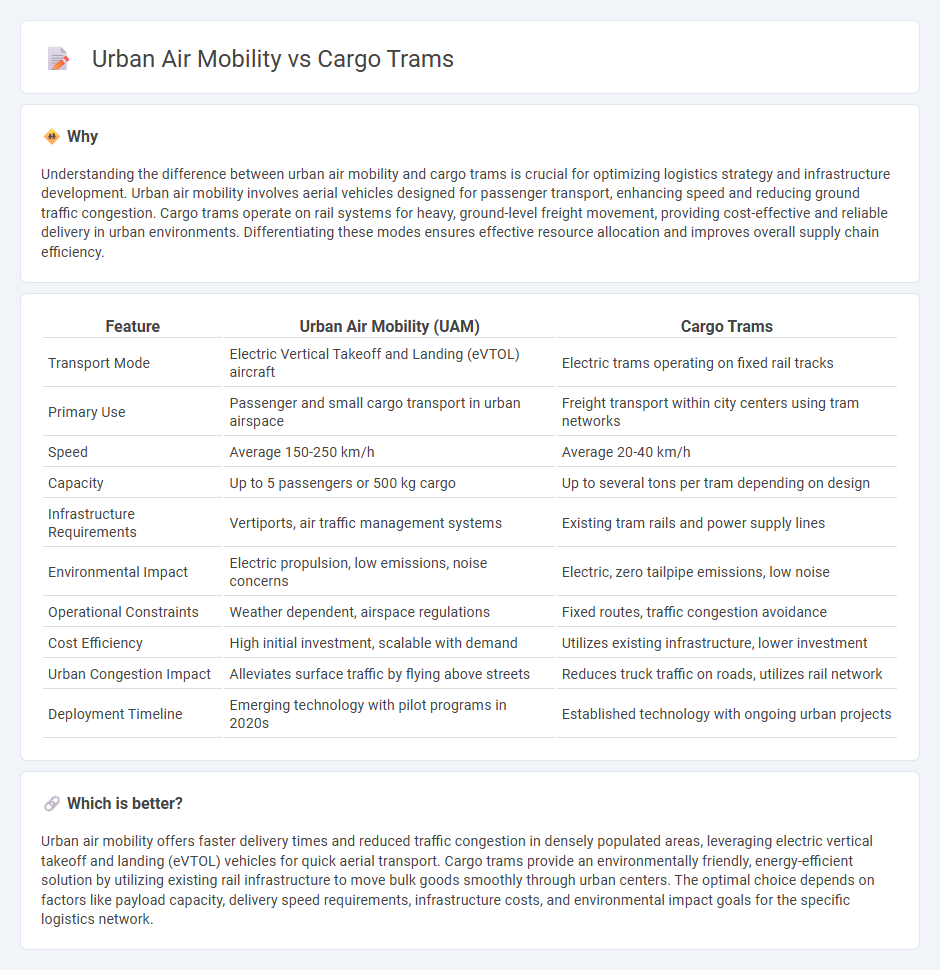
Urban air mobility offers rapid, flexible passenger transport above congested city streets, leveraging drones and eVTOL aircraft to bypass ground traffic. Cargo trams utilize existing rail infrastructure for efficient, high-volume freight movement within urban areas, reducing road congestion and emissions. Explore the advantages and challenges of these innovative logistics solutions shaping the future of urban transportation.
Why it is important
Understanding the difference between urban air mobility and cargo trams is crucial for optimizing logistics strategy and infrastructure development. Urban air mobility involves aerial vehicles designed for passenger transport, enhancing speed and reducing ground traffic congestion. Cargo trams operate on rail systems for heavy, ground-level freight movement, providing cost-effective and reliable delivery in urban environments. Differentiating these modes ensures effective resource allocation and improves overall supply chain efficiency.
Comparison Table
| Feature | Urban Air Mobility (UAM) | Cargo Trams |
|---|---|---|
| Transport Mode | Electric Vertical Takeoff and Landing (eVTOL) aircraft | Electric trams operating on fixed rail tracks |
| Primary Use | Passenger and small cargo transport in urban airspace | Freight transport within city centers using tram networks |
| Speed | Average 150-250 km/h | Average 20-40 km/h |
| Capacity | Up to 5 passengers or 500 kg cargo | Up to several tons per tram depending on design |
| Infrastructure Requirements | Vertiports, air traffic management systems | Existing tram rails and power supply lines |
| Environmental Impact | Electric propulsion, low emissions, noise concerns | Electric, zero tailpipe emissions, low noise |
| Operational Constraints | Weather dependent, airspace regulations | Fixed routes, traffic congestion avoidance |
| Cost Efficiency | High initial investment, scalable with demand | Utilizes existing infrastructure, lower investment |
| Urban Congestion Impact | Alleviates surface traffic by flying above streets | Reduces truck traffic on roads, utilizes rail network |
| Deployment Timeline | Emerging technology with pilot programs in 2020s | Established technology with ongoing urban projects |
Which is better?
Urban air mobility offers faster delivery times and reduced traffic congestion in densely populated areas, leveraging electric vertical takeoff and landing (eVTOL) vehicles for quick aerial transport. Cargo trams provide an environmentally friendly, energy-efficient solution by utilizing existing rail infrastructure to move bulk goods smoothly through urban centers. The optimal choice depends on factors like payload capacity, delivery speed requirements, infrastructure costs, and environmental impact goals for the specific logistics network.
Connection
Urban air mobility (UAM) enhances logistics by integrating aerial transport solutions with existing cargo tram networks, creating a seamless, multimodal freight system. These technologies optimize last-mile delivery by reducing congestion and improving speed through synchronized scheduling and automated routes. Combining UAM and cargo trams leverages vertical and ground-level transit efficiencies, transforming urban freight logistics and reducing carbon emissions.
Key Terms
Last-Mile Delivery
Cargo trams leverage existing urban rail infrastructure to efficiently transport goods through congested city centers, reducing road traffic and emissions for last-mile delivery. Urban air mobility (UAM) employs electric vertical takeoff and landing (eVTOL) vehicles to bypass ground traffic entirely, promising faster delivery times but facing regulatory and noise challenges. Explore the latest advancements and comparative benefits of cargo trams and UAM in last-mile logistics by diving deeper into smart transportation solutions.
Infrastructure Requirements
Cargo trams require robust ground infrastructure such as dedicated railway tracks, loading bays, and integrated urban logistics hubs to ensure efficient freight movement within city environments. Urban air mobility (UAM) systems demand specialized vertiports, advanced air traffic management solutions, and compliance with stringent aviation safety standards to support vertical takeoff and landing operations. Explore further to understand how these divergent infrastructure needs shape the future of urban freight and passenger transport.
Payload Capacity
Cargo trams typically offer substantial payload capacities, often ranging from 10 to 50 tons per tram, making them ideal for heavy urban freight transport along fixed rail routes. Urban air mobility (UAM) vehicles, designed for aerial logistics, usually handle lighter payloads around 200 to 500 kilograms due to current battery and lift technology limitations. Explore detailed comparisons and future advancements in payload capacity for cargo trams and UAM to better understand their roles in urban freight solutions.
Source and External Links
Could tramways help cities to tackle freight? - Fragile is developing a self-driving cargo tram system to utilize existing tram tracks for freight transport in cities.
Freight trams of Europe - This article highlights examples of freight trams in Europe, such as the CarGoTram in Dresden and the Cargo-Tram in Zurich.
CarGoTram - The CarGoTram was a freight tram in Dresden, Germany, which operated from 2001 to 2020, supplying Volkswagen's factory with car parts.
 dowidth.com
dowidth.com